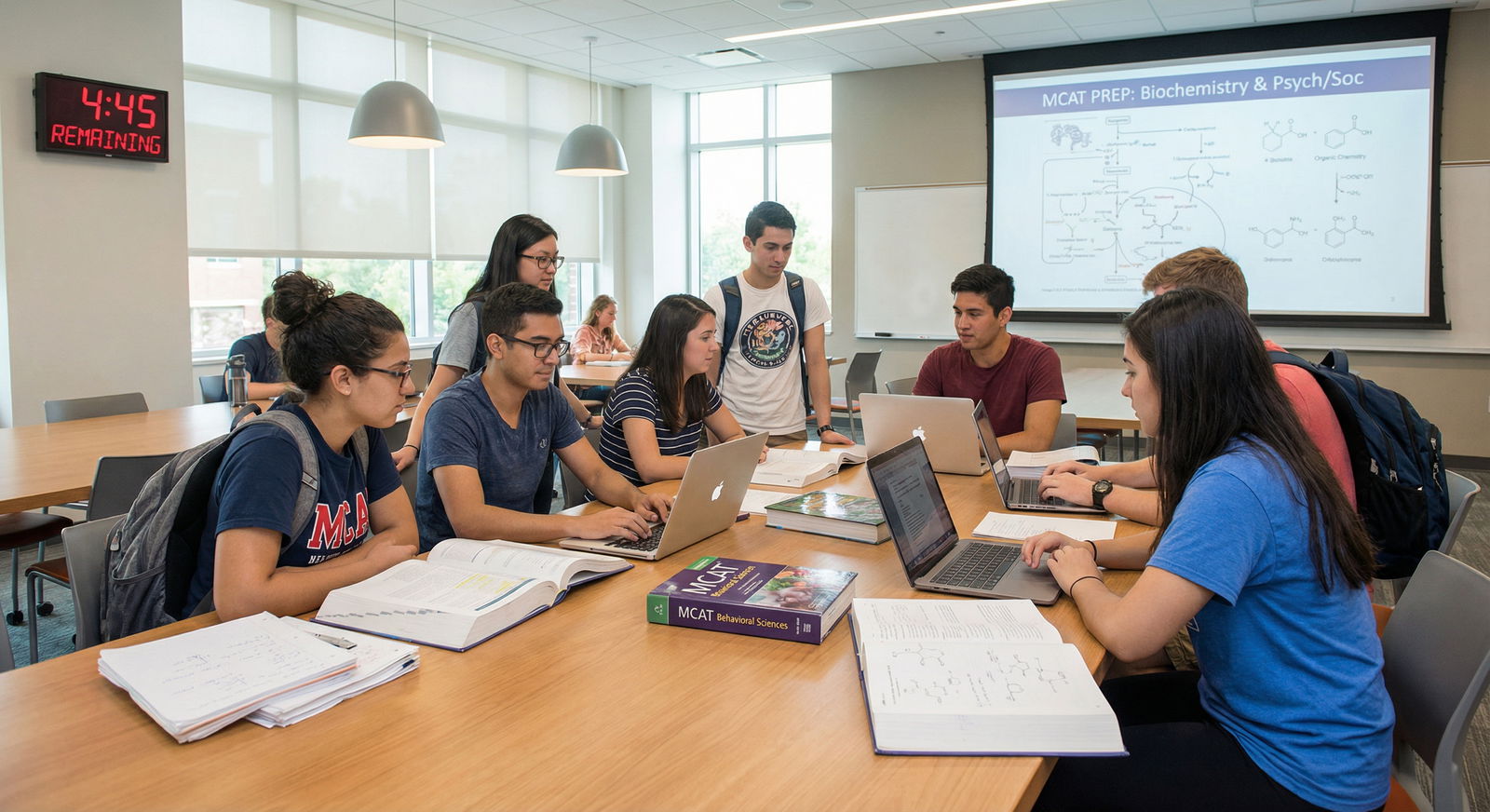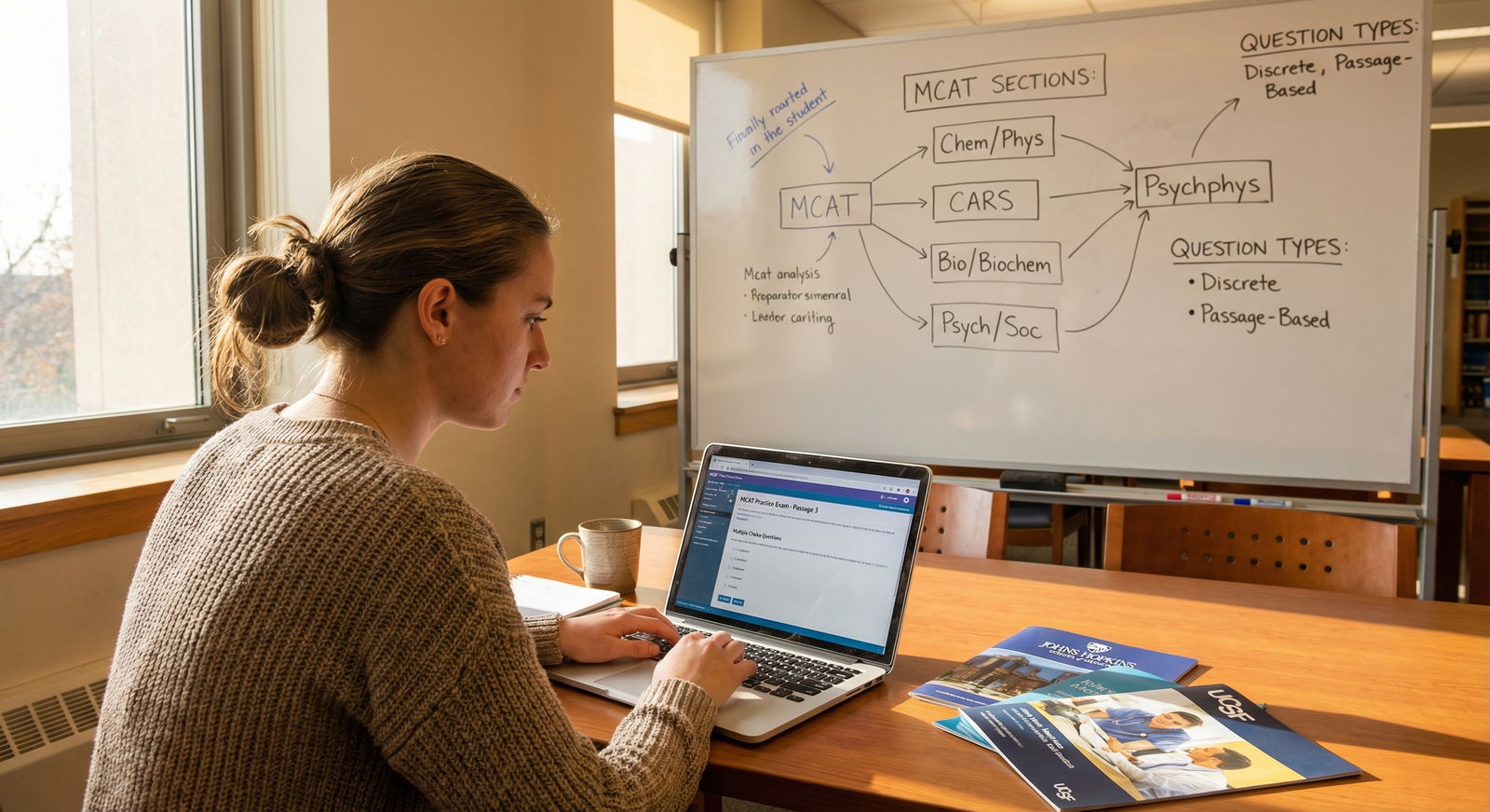MCAT Preparation Made Easy: Ultimate Guide to Exam Strategy & Tips

The Medical College Admission Test (MCAT) is one of the most important milestones on the path to medical school. It doesn’t just test facts—it evaluates how well you can apply foundational science and reasoning skills to real-world scenarios in medicine and health. Understanding the test structure, mastering each section, and building effective exam strategies are central to strong MCAT preparation and a successful medical school admissions outcome.
This guide breaks down the MCAT sections in detail, clarifies the test structure and scoring, and offers targeted study tips so you can approach exam day with confidence.
Understanding the MCAT Exam Structure and Scoring
Before you dive into content review or practice questions, you need a clear picture of what you’re preparing for. The MCAT is a computer-based, standardized exam administered by the AAMC that assesses:
- Foundational science knowledge
- Scientific reasoning and problem-solving
- Critical analysis and reading comprehension
- Understanding of behavior, psychology, and social determinants of health
The Four MCAT Sections
The exam consists of four main sections:
- Biological and Biochemical Foundations of Living Systems (Bio/Biochem)
- Chemical and Physical Foundations of Biological Systems (Chem/Phys)
- Psychological, Social, and Biological Foundations of Behavior (Psych/Soc)
- Critical Analysis and Reasoning Skills (CARS)
Each section has a similar structure:
- 59 questions (except CARS, which also has 53 questions in current formats; always verify with AAMC)
- Passage-based questions (majority) plus some discrete (stand-alone) questions
- 95 minutes per science or Psych/Soc section; 90 minutes for CARS
Including breaks and instructional screens, the full MCAT day is about 7.5 hours, making stamina and focus essential parts of your preparation.
Scoring Overview
- Each section is scored from 118 to 132 (125 being the midpoint).
- Your total score is the sum of all four sections: 472 to 528, with 500 at the center of the scale.
- Medical schools typically examine:
- Total score
- Section balance (large discrepancies can raise questions)
- How your score compares to their matriculant averages
Understanding this structure allows you to craft targeted exam strategies: which sections to prioritize, how to pace yourself, and how to simulate the real test in practice.
Section 1: Biological and Biochemical Foundations of Living Systems
This section evaluates how well you understand the molecular and cellular basis of life and how these principles relate to organ systems and whole-body function—core foundations for medical practice.
Content Focus and Test Structure
Bio/Biochem integrates:
- Biology (especially cell biology and physiology)
- Biochemistry
- Some general and organic chemistry concepts
- Basic scientific inquiry and research methods
You can expect:
- Passage-based questions describing experimental setups, data tables, figures, or clinical scenarios
- A smaller number of discrete questions that test standalone facts and concepts
High-Yield Content Areas
Key content domains include:
Cell structure and function
- Eukaryotic vs. prokaryotic cells
- Membrane transport (diffusion, osmosis, active transport)
- Organelles and their roles (mitochondria, ER, Golgi, lysosomes)
Biomolecules and macromolecules
- Protein structure and function (primary–quaternary, enzymes, kinetics)
- Nucleic acids (DNA/RNA structure, replication, transcription, translation)
- Carbohydrates and lipids (energy storage, membranes, signaling)
Metabolic pathways and bioenergetics
- Glycolysis, Krebs cycle, oxidative phosphorylation
- Electron transport chain, ATP generation
- Regulation of metabolism and hormonal control
Genetics and molecular biology
- Mendelian genetics, inheritance patterns
- Gene expression, regulation, and epigenetics
- Mutations, DNA repair, and biotechnology (PCR, cloning, etc.)
Human organ systems
- Nervous, endocrine, cardiovascular, respiratory, renal, digestive, immune
- Homeostasis and inter-organ communication
Exam Strategies and Study Tips for Bio/Biochem
1. Think in pathways, not isolated facts
Don’t just memorize steps; understand inputs, outputs, regulation, and clinical relevance. For example, when reviewing glycolysis, be able to answer:
- What happens if a key enzyme is inhibited?
- How does insulin vs. glucagon affect this pathway?
2. Use diagrams and tables aggressively
Redraw metabolic pathways, signaling cascades, and feedback loops. Visual representations are powerful for:
- Recognizing enzyme names and their substrates
- Distinguishing similar processes (e.g., glycolysis vs. gluconeogenesis)
- Connecting different organ systems and biochemical processes
3. Prioritize experimental passages
MCAT passages often describe experiments involving:
- Knockout mice or mutated proteins
- Enzyme inhibition and kinetics
- Changes in gene expression
Practice interpreting graphs, tables, and experimental design. Ask yourself:
- What is the independent variable?
- What is being measured?
- What is the author trying to conclude?
4. Integrate with your coursework
If you are still in undergrad, align your MCAT preparation with biology and biochemistry courses:
- After each lecture, ask: “How could this be tested on the MCAT?”
- Create MCAT-style questions from your class notes.

Section 2: Chemical and Physical Foundations of Biological Systems
This section tests how well you can apply general chemistry, organic chemistry, physics, and basic biology to understand the physical and chemical principles underlying living systems.
Content Focus and Question Types
Chem/Phys questions are rooted in:
- General chemistry (equilibria, acids/bases, kinetics, thermodynamics)
- Organic chemistry (structure, reactions, functional groups)
- Physics (mechanics, fluids, electricity, optics)
- Biochemistry and biology contexts (e.g., protein folding, hemodynamics)
Most questions are passage-based, often involving:
- Laboratory experiments
- Clinical devices (e.g., ventilators, imaging modalities)
- Biochemical or physiological scenarios with an underlying physics or chemistry principle
High-Yield Content Areas
General Chemistry
- Atomic structure, periodic trends
- Chemical bonding and intermolecular forces
- Solutions, concentration, solubility
- Acids, bases, buffers, and pH/pKa
- Redox reactions and electrochemistry
Organic Chemistry
- Functional groups (alcohols, carbonyls, amines, carboxylic acids)
- Stereochemistry and isomerism
- Nucleophiles, electrophiles, leaving groups
- Common reaction types (substitution, elimination, addition)
Physics
- Kinematics and forces (Newton’s laws)
- Work, energy, power
- Fluids: pressure, flow, Bernoulli’s principle (key for cardiovascular questions)
- Electrostatics and circuits (voltage, current, resistance)
- Waves, sound, optics (lenses, mirrors, refraction)
Math Skills
- Algebraic manipulation
- Ratio/proportion reasoning
- Scientific notation and estimation
- Dimensional analysis
Exam Strategies and Study Tips for Chem/Phys
1. Build a formula sheet—but go beyond memorization
Know the common MCAT equations (kinematics, PV=nRT, Bernoulli, Ohm’s law, etc.), but also:
- Understand what each term means physically
- Recognize when an equation does or does not apply (e.g., constant acceleration)
As you solve practice questions, ask: “How did I know which equation to use?”
2. Practice mental math and estimation
The MCAT is calculator-free. To speed up:
- Approximate: 3.14 as 3, 9.8 m/s² as 10 m/s²
- Round numbers to 1–2 significant figures
- Quickly compare answer choices by order of magnitude
3. Connect physics to physiology
Relate abstract physics concepts to biological systems:
- Blood flow and pressure → Poiseuille’s law, Bernoulli’s equation
- Respiratory mechanics → gas laws (Boyle’s, Dalton’s)
- Neuronal signaling → circuits and potential differences
These connections make concepts more intuitive and memorable.
4. Use practice questions to identify weak spots
Content review alone isn’t enough. After each practice set:
- Categorize missed questions: content gap, misreading, or math error
- Return to content review if you repeatedly miss questions in the same topic (e.g., fluids, acid–base)
Section 3: Psychological, Social, and Biological Foundations of Behavior
This section recognizes that medicine is not just biology and chemistry—it’s also about people, communities, and behavior. It tests how well you understand the psychological, social, and cultural factors that influence health and healthcare.
Content Focus and Relevance
Psych/Soc draws on:
- Introductory psychology
- Introductory sociology
- Some biology and brain structure/function
The goal is to assess your understanding of:
- Behavior and cognition
- Mental health and psychological disorders
- Social structures and institutions
- Culture, identity, and inequality
- Health disparities and social determinants of health
High-Yield Content Areas
Major psychological theories and perspectives
- Behaviorism, cognitive psychology, psychoanalytic, humanistic
- Learning theories: classical conditioning, operant conditioning, observational learning
- Motivation and emotion (e.g., drive reduction, Maslow, James-Lange, Cannon-Bard, Schachter-Singer)
Sensation, perception, and cognition
- Attention, memory types, and memory errors
- Cognition, problem-solving, and decision-making biases
- Language development and processing
Identity and personality
- Self-concept, self-esteem, self-efficacy
- Theories of identity (Erikson, Kohlberg, Freud)
- Personality theories (trait, biological, social-cognitive)
Psychological disorders and treatment
- Mood, anxiety, psychotic, personality, neurodevelopmental disorders
- Diagnostic and treatment basics
Sociology and social interaction
- Social institutions (family, education, healthcare, religion)
- Culture, norms, values, socialization
- Social stratification, class, race/ethnicity, gender, and inequality
- Social capital, cultural capital, social mobility
Health and behavior
- Health disparities and inequities
- Social determinants of health
- Stigma, discrimination, and access to care
Exam Strategies and Study Tips for Psych/Soc
1. Use concept maps and frameworks
Psych/Soc is concept-heavy but often less mathematically demanding. Concept maps help you:
- Organize theories by domain (identity, learning, motivation, etc.)
- Distinguish similar terms (e.g., role strain vs. role conflict, prejudice vs. discrimination)
- Understand how individual behavior fits into a larger social context
2. Master definitions—but test them in context
Flashcards (physical or digital) work well for:
- Key terms (e.g., fundamental attribution error, groupthink, anomie)
- Theorists and their contributions
However, always follow flashcards with passage-based practice to ensure you can apply these definitions.
3. Think like a future physician
When reading a passage on, for example, low vaccination uptake in a community, consider:
- Cultural beliefs, mistrust, past discrimination
- Structural barriers (transportation, cost, clinic hours)
- Education and health literacy
This mindset not only improves performance on the MCAT but also prepares you for real-world patient care.
Section 4: Critical Analysis and Reasoning Skills (CARS)
CARS is often the most challenging section for test-takers because it tests skills, not content. There are no outside facts to memorize; everything you need is in the passage.
What CARS Measures
CARS evaluates:
- Reading comprehension
- Critical thinking and reasoning
- Ability to analyze, evaluate, and apply arguments and ideas
Passages come from:
- Humanities (philosophy, ethics, literature, art criticism)
- Social sciences (history, political science, anthropology)
Each passage is followed by questions that ask you to:
- Identify main ideas and themes
- Infer author’s tone, attitude, and intent
- Evaluate arguments and evidence
- Apply or extrapolate ideas to new scenarios
Exam Strategies and Study Tips for CARS
1. Read actively, not passively
As you read:
- Identify the main thesis or argument early
- Note the author’s tone (supportive, critical, skeptical, neutral)
- Distinguish between main ideas and supporting details
Mentally summarize each paragraph in a short phrase (e.g., “background,” “counterargument,” “evidence,” “conclusion”).
2. Avoid outside knowledge and personal opinions
CARS questions must be answered only from the passage. Even if you know something about the topic:
- Do not insert external facts or biases
- Ask: “What does the passage say, and how does the author frame it?”
3. Develop a consistent timing strategy
Under timed conditions, you must balance:
- Speed (to complete all passages)
- Comprehension (to avoid re-reading)
Many students find success with:
- ~9–10 minutes per passage (including questions)
- If stuck between two answers, eliminate clearly wrong options, then choose the one most consistent with the author’s main point and tone
4. Practice regularly, not just right before the exam
CARS is like learning a language or instrument—it improves with consistent, long-term practice. Incorporate:
- 1–2 passages per day early in your prep
- Gradually increase to several passages in a row to build stamina
Reading challenging material in your free time (editorials, long-form essays, philosophy excerpts) can indirectly boost CARS performance.
Building an Effective MCAT Preparation Plan
Content knowledge alone is not enough. High scorers combine structured planning, targeted practice, and realistic test simulation.
Step 1: Diagnose Your Starting Point
- Take a full-length diagnostic exam or an official AAMC sample test.
- Evaluate:
- Overall score and section scores
- Types of questions missed
- Timing issues or fatigue
This helps determine:
- Whether you need a longer preparation timeline (e.g., 4–6 months)
- Which sections require more intensive review
Step 2: Create a Structured, Realistic Study Schedule
For most students, MCAT preparation ranges from 300–500+ hours spread over 3–6 months, depending on:
- Your starting knowledge base
- Other obligations (work, school, family)
- Target score and school list
Build a plan that includes:
Content review phase (first 4–8 weeks):
- Systematic review of Bio/Biochem, Chem/Phys, Psych/Soc
- CARS practice several times per week
Practice and refinement phase (middle portion):
- Daily practice questions (from multiple resources)
- Strategy refinement (timing, guess strategies, test-day routine)
Full-length exam phase (last 4–6 weeks):
- Weekly or bi-weekly full-length exams
- Detailed review of every missed or guessed question
Step 3: Use High-Quality MCAT Resources
Consider combining resources for optimal coverage:
Official AAMC resources (non-negotiable)
- AAMC Full-Length Practice Exams
- Question Packs and Section Banks
- Official Guide and sample questions
Commercial prep materials
- Kaplan, Princeton Review, Examkrackers, or similar comprehensive books
- Specialty books for CARS, Psych/Soc, or specific science topics
Free or low-cost resources
- Khan Academy MCAT videos (archived but still very helpful)
- Anki decks or other spaced-repetition tools
- Forums and discussion boards for explanations (use critically)
Step 4: Simulate Real Test Conditions
Full-length exams are crucial for building endurance and pacing:
- Take them at the same time of day as your scheduled exam.
- Use strict timing and official breaks.
- No distractions: no phone, social media, or multi-tasking.
After each exam:
- Review not just what you got wrong, but why:
- Misread question?
- Content gap?
- Rushed due to time?
- Adjust your study plan based on recurring patterns.
Step 5: Maintain Wellness and Stamina
Your brain performs best when your body is cared for:
- Sleep: Aim for 7–9 hours regularly, especially in the weeks before your exam.
- Nutrition and hydration: Practice your test-day meals during full-lengths.
- Stress management: Exercise, mindfulness, or relaxation techniques can help maintain focus and prevent burnout.

Frequently Asked Questions About MCAT Sections and Preparation
1. How many hours should I study for the MCAT, and how should I divide time across sections?
Most students benefit from 300–500 hours of focused MCAT preparation, though some may need more depending on their starting point. A rough framework:
- Bio/Biochem: 25–30% of total time
- Chem/Phys: 25–30%
- Psych/Soc: 20–25%
- CARS: 15–20% (but practiced consistently throughout)
Initially, focus more on content-heavy sections where your coursework is weaker. As you progress, shift time toward practice questions, passage analysis, and full-length exams.
2. What are the best resources for learning the test structure and practicing Exam Strategies?
To understand the MCAT test structure and refine exam strategies:
- Use the AAMC Official Guide to the MCAT and their online resources for the most accurate overview of format and scoring.
- Leverage AAMC practice exams and Section Banks to see how real questions are structured.
- Commercial prep courses or books often provide step-by-step strategies for pacing, triaging difficult questions, and managing CARS passages.
- Track your performance metrics (accuracy, timing, endurance) after each practice set and adjust strategies accordingly.
3. How important is the MCAT score in medical school admissions?
The MCAT score is a critical component of medical school admissions. It provides:
- A standardized metric to compare applicants from different schools and backgrounds
- Evidence of readiness for the academic rigor of medical school
However, admissions committees also consider:
- GPA and academic trends
- Clinical, research, and volunteer experiences
- Letters of recommendation
- Personal statement and secondary essays
- Interview performance
A strong MCAT score can open doors to more schools and scholarships, while a weak score can limit options—even with a solid GPA—so it’s worth investing in thorough MCAT preparation.
4. How far in advance should I start MCAT preparation relative to my test date and application cycle?
Ideally, plan your MCAT date so that:
- You can dedicate 3–6 months of focused study beforehand
- Your score is available before you submit your primary medical school applications (typically late spring to early summer for AMCAS)
If you’re balancing school or work, consider:
- Lighter but longer preparation (e.g., 6–9 months part-time)
- Building a strong foundation in core prerequisite courses (biology, chemistry, physics, psychology, sociology) before intensive test prep
5. How can I improve if I’m plateauing in one section, especially CARS?
Plateaus are common. To break through:
For CARS:
- Increase passage frequency (daily practice).
- Focus on reviewing explanations in depth, not just checking right answers.
- Analyze why wrong answers are wrong and right answers are right based on the passage.
- Try different reading strategies (e.g., focusing more on structure, less on details) and see which improves your accuracy.
For science or Psych/Soc sections:
- Identify specific topics with persistent errors (e.g., fluids, enzyme kinetics, learning theories).
- Revisit targeted content and then immediately do questions on that topic.
- Seek alternative explanations (videos, different textbooks, tutoring) if concepts aren’t clicking.
Final Thoughts: Turning MCAT Sections into a Strategic Advantage
Success on the MCAT isn’t about memorizing every fact from every textbook. It’s about:
- Understanding the test structure and what each section is truly measuring
- Developing strong exam strategies and study tips tailored to your strengths and weaknesses
- Applying foundational science and reasoning skills to novel scenarios, just as you’ll be expected to do in medical school and clinical practice
By carefully breaking down each MCAT section—Biological and Biochemical Foundations, Chemical and Physical Foundations, Psychological, Social and Biological Foundations, and CARS—you can design an efficient, targeted MCAT preparation plan that maximizes your potential.
Approach your prep systematically, practice under realistic test conditions, learn from every mistake, and prioritize both academic and personal well-being. This combination will not only position you for a competitive MCAT score but also lay the groundwork for success in medical school and beyond.

SmartPick - Residency Selection Made Smarter
Take the guesswork out of residency applications with data-driven precision.
Finding the right residency programs is challenging, but SmartPick makes it effortless. Our AI-driven algorithm analyzes your profile, scores, and preferences to curate the best programs for you. No more wasted applications—get a personalized, optimized list that maximizes your chances of matching. Make every choice count with SmartPick!
* 100% free to try. No credit card or account creation required.













